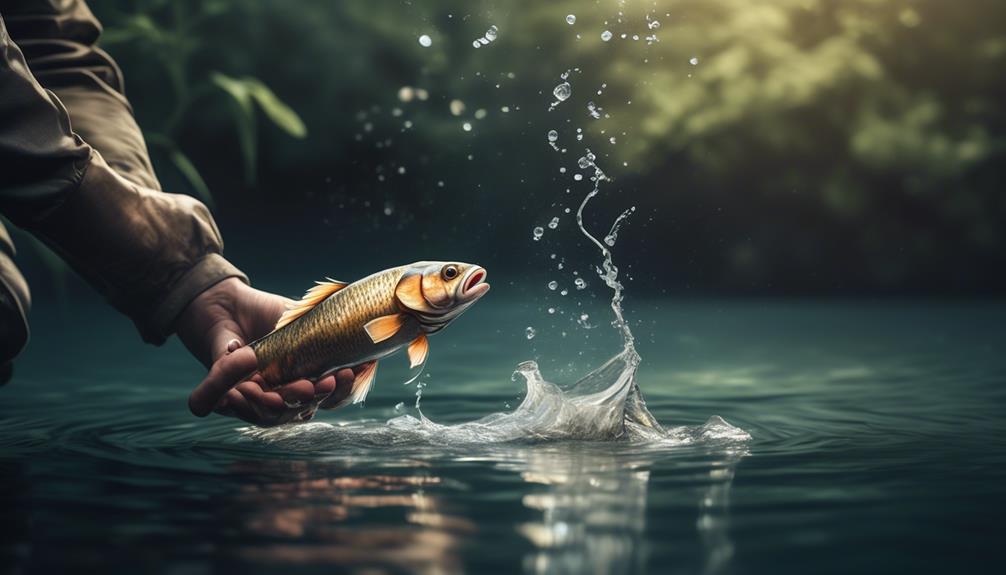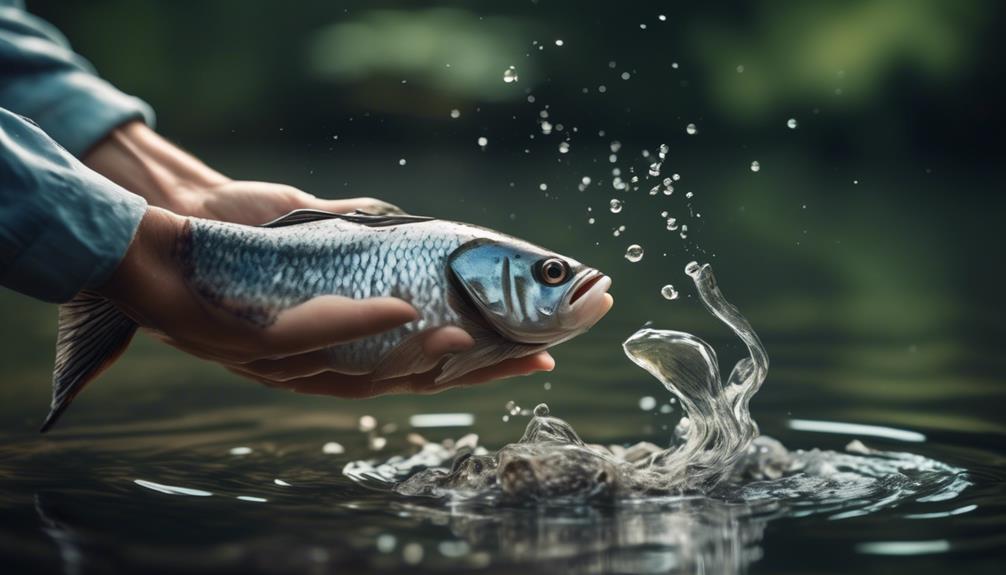As an angler, you may have felt the tug on your line and the rush of excitement as you reel in a fish, only to release it back into the water.
But have you ever considered the impact of this catch and release practice on the fish? The effects of catch and release on fish are far-reaching and often go unnoticed.
From the stress and physical exhaustion experienced by the fish to the long-term population effects, there are numerous factors to consider when it comes to catch and release.
Understanding these effects is crucial for the conservation and management of fish populations, and it may just change the way you approach your next fishing trip.
Stress and Physical Exhaustion
When handling fish during catch and release, it's important to minimize stress and physical exhaustion to ensure their well-being after release. Proper handling techniques are crucial for maintaining fish welfare. Stress indicators in fish include accelerated gill movement, erratic swimming, and excessive mucus production. These signs indicate that the fish is experiencing stress and may lead to physical exhaustion.
To minimize stress, it's vital to handle the fish with care and efficiency. Avoiding prolonged air exposure, using wet hands, and supporting the fish properly can significantly reduce stress levels. Additionally, employing barbless hooks and appropriate tackle can make the release process smoother, reducing the risk of exhaustion.
After catching a fish, the recovery strategies employed during handling and release play a significant role in ensuring the fish's well-being. Once the fish is properly handled and released, it's essential to monitor its recovery. Providing the fish with a gentle and controlled release, allowing it to regain its strength before swimming away, is crucial for its recovery. Observing the fish to ensure it swims away strongly is a key indicator of successful recovery.
Injury and Mortality Rates
To ensure the well-being of the fish after release, minimizing stress and physical exhaustion is crucial, and understanding the injury and mortality rates resulting from catch and release practices is equally important for sustainable fishing.
When it comes to injury and mortality rates in catch and release fishing, several factors come into play:
- Catch Handling: Proper catch handling techniques significantly affect fish health post-release. Avoiding damage to gills, eyes, and scales during hook removal and minimizing air exposure can reduce the likelihood of injuries that may lead to mortality.
- Human Intervention: Human intervention post-catch, such as using wet hands or a wet cloth to handle the fish, can help maintain the protective mucus layer on the fish's skin, which is crucial for their well-being.
- Fish Well-being: Monitoring the fish for signs of exhaustion or injury before release is vital. If a fish shows signs of distress, providing adequate time for recovery before release can improve its chances of survival.
- Barbless Hooks: Using barbless hooks can facilitate easier hook removal, reducing the risk of injury to the fish and improving its chances of survival after release.
Understanding the dynamics of injury and mortality rates resulting from catch and release practices is essential for anglers and fisheries management. By implementing proper catch handling techniques and minimizing human intervention, the overall well-being and survival rates of released fish can be significantly improved, contributing to sustainable fishing practices.
Behavioral Changes
Minimizing stress and physical exhaustion in fish during catch and release practices is essential for understanding the behavioral changes that may occur post-release. When fish are repeatedly caught and released, they can become habituated to the experience, leading to altered responses to predators. Habituation may reduce their natural fear response, making them more vulnerable to predation.
Additionally, the stress of being caught and handled can impact a fish's foraging behavior. It may take some time for the fish to resume normal feeding patterns, affecting their overall health and energy reserves.
Furthermore, territorial disputes among fish can be disrupted after catch and release. Fish often establish territories for nesting, feeding, and breeding. When they're caught and released, they may lose their established territory, causing conflicts and stress as they try to re-establish their position within the social hierarchy. This can lead to increased aggression and competition among fish, impacting their overall well-being and reproductive success.
Survival and Recovery Time
After experiencing the potential behavioral changes resulting from catch and release, it's crucial to understand the impact on a fish's survival and recovery time. When a fish is caught and released, its chances of survival and recovery depend on various factors, including its species, size, and the conditions in which it was caught. Here are some key considerations to take into account:
- Recovery strategies: Different species of fish may require different recovery strategies after being caught and released. Some fish may benefit from being gently cradled in the water to allow water to flow through their gills and aid in their recovery. Others may need to be actively swum back and forth in the water to help oxygen flow through their systems. Understanding the specific recovery needs of different fish species is essential for promoting their survival after catch and release.
- Habitat conditions: The environment in which a fish is released back into the water plays a significant role in its survival and recovery. If the habitat is rich in oxygen and suitable for the species, the fish is more likely to recover quickly and survive. Conversely, if the habitat is polluted or lacks the necessary resources, the fish's recovery may be hindered, impacting its chances of survival.
Understanding these factors and implementing appropriate recovery strategies while considering habitat conditions can significantly improve the survival and recovery time of fish after catch and release.
Reproductive Success
Improving the reproductive success of released fish is a key concern in catch and release practices. When fish are caught and released, their ability to contribute to the gene pool of their species can be affected. Genetic diversity is crucial for the long-term survival of fish populations, and catch and release can play a role in maintaining this diversity. When released, fish may face reproductive competition, impacting their ability to successfully mate and pass on their genetic traits. This competition can potentially lead to changes in the genetic makeup of the population over time.
Mate selection is another important aspect of reproductive success for released fish. The experience of being caught and handled by anglers could influence the ability of fish to attract mates. Additionally, the stress of capture and release could affect a fish's ability to compete for mates, potentially impacting the success of fertilization.
Furthermore, the success of fertilization in released fish is a critical factor in their reproductive success. The physical stress of being caught and subsequently released may impact the reproductive organs and overall reproductive health of the fish, potentially affecting their ability to fertilize or produce viable offspring.
Immune System Impacts
Understanding the effects of catch and release on the immune system of fish is crucial for assessing the overall impact on their health and survival. When fish are subjected to the stress of being caught and then released, it can have significant implications for their immune system. Here are some notable impacts:
- Immunological Response: The stress of catch and release can lead to a suppression of the fish's immune system. This suppression can make the fish more susceptible to diseases and infections, ultimately compromising their overall health.
- Increased Stress Hormone Levels: When fish are caught and handled, their stress hormone levels can spike. Elevated stress hormone levels can suppress the immune system, making the fish more vulnerable to pathogens and reducing their ability to fight off infections.
- Prolonged Effects: The impact of catch and release on the immune system can be long-lasting. Even after being released, fish may continue to experience suppressed immune function, leaving them vulnerable to health challenges in the days and weeks following the stressful event.
- Overall Health and Survival: The compromised immune system of fish due to catch and release stress can have implications for their long-term health and survival. It's essential to consider these immunological impacts when evaluating the sustainability of catch and release practices.
Understanding how catch and release practices impact the immune system of fish is critical for making informed decisions about conservation and sustainable fishing practices.
Growth and Development

How does catch and release fishing impact the growth and development of fish in their natural habitats? This practice can have significant implications for the growth and development of fish.
When fish are caught and released, they may experience stress, which can affect their nutritional needs and overall development. Stress from the capture and release process can lead to a decrease in appetite and lower food consumption, potentially impacting their ability to meet their nutritional needs for optimal growth.
Additionally, environmental factors play a crucial role in the growth and development of fish. When fish are caught and released, they may experience changes in their surroundings, including variations in water temperature and oxygen levels. These environmental shifts can impact their growth patterns and development. For example, sudden changes in water temperature can affect the metabolic rate of fish, potentially influencing their growth rates.
Furthermore, the handling and release process can cause physical injuries to fish, which can hinder their growth and development. These injuries may impact their ability to forage for food or evade predators, ultimately affecting their overall development within their natural habitat.
Long-Term Population Effects
You can observe long-term population effects in fish species subjected to catch and release practices, which may impact the overall dynamics of their ecosystems. Understanding these effects is crucial for managing fish populations sustainably.
- Genetic Diversity: Catch and release can influence the genetic diversity of fish populations. Releasing larger, more reproductively successful fish may alter the genetic composition of the population over time, potentially affecting their ability to adapt to changing environmental conditions.
- Adaptation: Over time, catch and release can drive changes in fish populations as they adapt to fishing pressure. Fish that exhibit certain behaviors, such as avoiding lures or hooks, may have a survival advantage, leading to shifts in the population's traits and behaviors.
- Ecological Niche: Catch and release practices can influence the ecological niche occupied by fish within their ecosystems. Changes in population size and composition can impact the interactions between fish species and their environment, potentially affecting the balance of the ecosystem.
- Competition: Long-term catch and release practices may alter the competitive dynamics among fish species. Changes in population sizes or the selective removal of certain individuals can influence competition for resources, potentially leading to shifts in the fish community structure and diversity.
These long-term population effects highlight the need for careful consideration of catch and release practices to ensure the sustainability of fish populations and their ecosystems.
Frequently Asked Questions
How Does Catch and Release Fishing Impact the Genetic Diversity of Fish Populations?
When you practice catch and release fishing, you directly affect the genetic adaptation and population dynamics of fish.
By releasing fish back into the water, you allow them to contribute to the gene pool, promoting genetic diversity within the population.
This diversity enhances the population's ability to adapt to changing environmental conditions and increases its overall resilience.
Therefore, catch and release fishing can have a positive impact on the genetic diversity of fish populations.
Are There Any Differences in the Effects of Catch and Release on Different Species of Fish?
When you're considering the effects of catch and release on different species of fish, it's important to note the differences in stress response and physiological recovery. This can impact their reproductive success and survival rates.
Some species may be more resilient to the process, while others might struggle to recover. Understanding these variations can help in developing more targeted and effective catch and release practices for different fish species.
Can Catch and Release Fishing Have Long-Term Effects on the Behavior of Fish, Such as Changes in Migration Patterns?
Catch and release fishing can indeed have long-term effects on fish behavior, such as changes in migration patterns. The stress response from being caught and released can impact their habitat use and alter their natural behavior.
Over time, this may lead to shifts in migration patterns as fish adapt to the stressors of catch and release. Understanding these effects is crucial for sustainable fishing practices and conservation efforts.
What Role Does Water Temperature Play in the Survival and Recovery Time of Fish After Being Caught and Released?
Water temperature significantly impacts the survival and recovery time of fish after catch and release. It affects their stress response, genetic diversity, and behavior changes.
Species-specific effects and population dynamics are influenced by water temperature, which in turn impacts ecosystem interactions. Understanding the role of water temperature is crucial in managing catch and release practices to minimize long-term effects on fish populations.
Are There Any Potential Indirect Effects of Catch and Release Fishing on Other Species in the Ecosystem, Such as Changes in Predator-Prey Dynamics?
When it comes to catch and release fishing, there can be potential indirect effects on other species in the ecosystem. Changes in predator-prey dynamics could occur, impacting the overall balance of the ecosystem. These changes have important conservation implications and should be carefully considered.
It's crucial to understand how catch and release practices may influence the broader ecosystem dynamics to ensure the conservation of all species involved.
Conclusion
In conclusion, catch and release fishing can have significant effects on fish, including stress, injury, and changes in behavior.
While some fish may ultimately survive and recover, others may experience long-term impacts on their population and reproductive success.
It's important for anglers to consider the potential consequences of catch and release and to practice responsible fishing techniques to minimize harm to fish populations.



